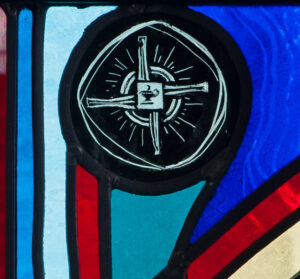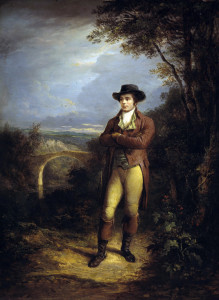We are on the approach this week to St. Brigid’s Day and Candlemas and these days represent a distinct shift in perspective in the Wheel of the Year: a shift toward spring, a shift away from Yule and Christmas and the celebrations of Midwinter that we have enjoyed for nearly 40 days now. It is, mind you, most definitely a perspective shift and not an experience shift: there is no denying the lengthening days here in the Northern Hemisphere, but we know winter is not done with us, not by a long shot. Be that as it may, with the arrival of February, we take our first step onto the bridge that leads us from winter to spring.
Lia Leendertz, in her Almanac for this year, relates a Scottish folktale about this phenomenon in her chapter for the month of February. In this tale, Beira, Goddess of Winter, has a magic staff in her possession and frost covers the land whenever she bangs the staff hard on the ground. In her icy kingdom, Beira holds a young woman called Brigid captive, and one day, Beira sends Brigid on an impossible errand: she gives Brigid a brown cloak and instructs her to wash it clean in the nearby icy stream and bring it back pure white. Brigid despairs. But Father Winter watches over her, and at the icy stream he turns the cloak white and presents Brigid, too, with a bouquet of lovely snowdrops. Brigid brings both these things to Beira, but Beira is outraged: the snowdrops are a sign –– a sign that her power is waning, and so she sets off in a huff across the land, banging her staff, bringing frost and snowfall wherever she roams.
The Goddess of Winter can’t hold on forever, though. The first day of February brings St. Brigid’s Day. Brigid, that same young woman charged with washing the brown cloak white, is our bridge from winter to spring. Her day is one of the four cross quarter days in the year; each is marked by accompanying holydays/holidays. The one we most recently celebrated was at the end of October and start of November: Halloween, All Saints Day, and All Souls Day –– the Days of the Dead. We were approaching winter; life was descending below the earth. But as February begins, this next period of cross quarter days mark the first stirrings of earth’s awakening on the approach to spring. The snowdrops are a sign of this; hence Beira’s outrage.
St. Brigid is sacred to Ireland and second in stature there only to St. Patrick. In the older earthbound religions, the First of February honors the Celtic goddess Brigid and brings the season of Imbolc. As the goddess goes, the old crone of winter is reborn now as the young maiden, for this is a time of renewal. The seeds that were planted beneath the earth last fall are preparing to bring forth lush green life, once spring truly arrives. For St. Brigid’s Day, it is traditional to fashion a St. Brigid’s Cross out of rushes or reeds (pictured in the stained glass window above), as well as to leave an oat cake and butter on a windowsill in your home. This, to encourage Brigid to visit your home and bless all who live there. Brigid is typically depicted holding her cross of rushes in one hand and an illuminated lamp in the other––bridging, again, the themes of light in the darkness of midwinter with the green of approaching spring.
Once the sun sets on St. Brigid’s Day, we enter into Candlemas Eve, and if you––like Seth and me in this house––have been delighting in Christmas all this month, now comes the time to put yuletide behind us. On the night of the First of February we will remove all yuletide greenery from our home as we return to nature what is hers. The cedar garland on the front door will come down, and the Christmas tree, which has brought such peaceful illumination to our home since just a few days before Christmas, will be carried outside and set to rest in a quiet corner of the yard. With Candlemas Eve, forty days will have passed since the Midwinter solstice and we find ourselves halfway from the solstice to the vernal equinox in March. Our old reliable 17th century Book of Days poet Robert Herrick describes the significance of this night in his poem “Ceremony Upon Candlemas Eve” as he provides the following instructions:
Down with the rosemary, and so
Down with the bays and misletoe;
Down with the holly, ivy, all,
Wherewith ye dress’d the Christmas Hall:
That so the superstitious find
No one least branch there left behind:
For look, how many leaves there be
Neglected, there (maids, trust to me)
So many goblins you shall see.
When the nights grow long again next December, that old tree will fuel our solstice fire, connecting one Christmas to the next. With Christmas removed (and goblins and ill luck kept at bay), our perspective shift will bring us on the Second of February to Candlemas, a beautiful celebration in its own rite, and the second step on the bridge to spring that Brigid lays before us. Candlemas is the day that candles are blessed in the church, but it is also known as Purification Day, which harkens back to an old Hebrew tradition: forty days after the birth of a son, women would go to the temple to be purified. Again, renewal. And so Mary did this, for it was her tradition, and when she did, it was there at the temple that she and her infant child ran into the elders Simeon and Anna, who recognized the child as “the Light of the World.” This is the basis for the blessing of candles on this day, and the day’s lovely name, which is even more beautiful in other languages: la Candelaria in Spanish, la Chandeleur in French. In France, the traditional evening meal for la Chandeleur is crêpes. In Mexico, la Candelaria is a night for tamales and hot chocolate, while the procession and celebration in Puno, Peru, is typically so big, it rivals that of Carnival in Rio de Janeiro. And while the First of February is the night that all remaining Yuletide greenery is removed from the home, traditional custom would have us keep nativity scenes up through Candlemas, the Second of February.
One of my favorite Candlemas traditions is to go through the house at sunset, lighting every lamp, even for just a few minutes. And my favorite song for the day is an old carol called “Jesus, the Light of the World.” Is it a carol for Candlemas? Who knows. Certainly the words echo those of Simeon and Anna, the elders in the temple, so for me, I say it is.
Most famously, perhaps, Candlemas is known as an old weather marker. As the old saying goes: If the sun shines bright on Candlemas day / The half of the winter’s not yet away. The tradition of Candlemas as weather marker is particularly strong in Germany. And while Candlemas itself is not celebrated with any great gusto here in the States, this remnant of tradition remains in our yearly observation on the Second of February of Groundhog Day, in which the observations of an old groundhog in Pennsylvania (where many Germans settled) determine how much longer winter will last. Did old Candlemas weather lore influence the traditions that revolve around Punxsutawney Phil? Of this we can be pretty certain.
SHOP OUR VALENTINE SALE!
Spend $85 across our catalog and take $10 off, plus get free domestic shipping, when you enter discount code LOVEHANDMADE at checkout. That’s a total savings of $19.50. Click here to start shopping. We’ve got some wonderful new handmade artisan goods from Mexico, as well as brand new handmade Murano glass dipping pens and lovely writing papers from Italy. Mom has made some brand new hand-embroidered tea towels, too, and we should get them on the website by the start of the month. I think you’ll find many nice ways to surprise your sweetheart and delight your darlin’. We’re also about to announce two new letterpress printed publications: our 2023 Copperman’s Day mini print, and our newest poetry broadside, which we printed at the Midwinter solstice. Shop at conviviobookworks.com… and your purchases translate into real support for real families, small companies, and artisans we know by name.
Image: Detail of the left light of the stained glass window in the north wall of the north transept of the Church of the Most Holy Rosary, Tullow, County Carlow, Ireland. The window was created by George Walsh (b. 1939), depicting the pavilion in the garden of the Brigidine Sisters in Tullow and St. Brigid’s Cross. Photo by Andreas F. Borchert, via Wikimedia Commons, 2013.


